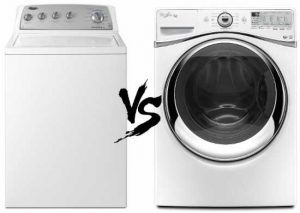Top Load vs Front Load Washers Pros Cons
Since front-loading washers returned in the late 1990s, consumers around the world have struggled to decide which type of washer (top load vs front load washers) is best. the new washers High efficiency front-loading or traditional top-loading washing machines.
The Washing machines are a necessity in most homes and buyers are always looking for ways to make sure they get what they pay for. This article will help you navigate the differences between top-loading washers and front-loading washers. so you can buy the best option for you.

Factors to consider while selecting between top-load and front-load washing machine
Top Load vs Front Load Washers; Which is Easier to Use?
Top-loading washing machines are generally cheaper because there is no need to fold to load and unload clothes. For older buyers or those with joint problems, top-loading washers are generally the ideal height to avoid the hassle of bending over.
To mitigate this problem with front loaders, it is recommended to install the units on linen supports that increase the units between 12 and 15 “.
The upper loaders also have other convenient qualities, such as the possibility of adding clothes in the middle of the cycle, or even only after the cycle has started. Top-loading washers can also collect lint and distribute the softener better than washers with front-loading
Winner: Top-loading washers
2) How fast do you wash?
Top-loading washers with agitator they tend to wash clothes faster than front-loading washing machines, which makes them ideal for moving buyers, the main reason is that clothes are constantly immersed in water in a top-loading washing machine.
Agitator vs. Impeller: Top Load Washer vs Front Loader

Keep in mind that not all major journals are the same. Today there are two main types of top-loading washing machines, one that has an agitator and one that doesn’t. An agitator is a mechanism inside a washer that creates movement by shaking and forcing water through the machine, which leads to a vibrating washer.
Top-loading washers with agitators generally wash faster, but top-loading washers without agitators (known as high-efficiency top-loading washers) clean better, can clean more clothes simultaneously, and use less water.
Therefore, HE (high efficiency) washing machines cost more. We reviewed the differences between the top agitator load washers and the top impeller loaders in our in-depth review.
Winner: top-load washers
3) Which one cleans better?
Although they are easier to place on the back, top-loading washers can also be harder on clothes, especially if the machine is overloaded. Front loaders are much more delicate with clothes. Even the main loaders have difficulty washing larger objects, such as pillows or comforters, since they do not sink completely into the water.
Winner: front-loading washing machines
4) Prices of Front-loading washing machines
Front-loading washing machines are generally more expensive, but rightly so. Front-loading washers offer cleaner quality and save more energy and water than top loaders.
Winner: tie between both
5) Which Uses Less Water? Top Load or front Load?
Front-loading washers provide superior cleaning and save more energy and water than top-loading washers. The second largest water expenditure for Americans comes from washing machines and front-loading washing machines can reduce this cost.
Even the medium front load washers use 40% less water than the medium high load washer, according to TXU Energy. Consumer reports also consistently rate front-loading washers as “excellent” and “very good” compared to main chargers that are normally considered “poor” or “fair”.
6) Installation flexibility
Front-loading washing machines have the ability to stack with a dryer, using less space than a top-loading dryer for consumers in smaller spaces. There are two popular reasons why users decide to opt for a stacked washer and dryer design.
The first is that they have no other option: many houses or rental units have their laundry games located in small closets where vertical space is the only space available. But even those who have extra space choose to go vertically because it allows them a more functional space that can be used to preserve or leave open for an attractive without bulk.
In many homes, space, among other details, is a decisive factor in choosing a washer and dryer. If you have limited space or an unusual configuration, be sure to check out our publication on compact washers and dryers. Gone are the days when consumers and homeowners are limited to industrial-grade laundry facilities that are immobile and monopolize space.
As the vertically stacked arrangements have become more popular, almost all the washers and dryers that are manufactured are designed to have stackable compatibility. Even larger units that may appear to be non-stackable are produced with the ability to stack vertically as a key feature.
Winner: front load washers
7) Spin speed
During the final spin cycle, front-loading washers generally spin 33% faster than typical top loaders, which means that more water will be removed from clothing before transferring it to the dryer.
This means that your clothes will dry faster in the dryer and will be less heavy to move between the two units. However, a disadvantage is that the spin cycle causes many front-loading washers to vibrate, making noise that many people prefer to avoid.
Winner: front-loading washers
8) Odour / Mold Problem
One of the biggest complaints about front-loading washers is that over time the mold can accumulate around the rubber seal on the door. To counter this, front-loading washers require much more maintenance than top-loading washers.
Top-loading washers do not have this problem because they depend on the severity to decompose the water, so the water is not trapped in any seal.
Winner: top-load washers
What is the Conclusion?
The components in front-loading washers are generally better than top-loading washers. Front-loading washers are more efficient in terms of energy and water and wash better than heavier load washers.
However, front-loading washers are more expensive than top-loading washers and gaskets require regular cleaning. It is advisable to place these washers in an area with good airflow and keep the door .slightly ajar between cycles to minimize mold and fungus problems.
If you have to insert a washing machine into a smaller space (and if you have more money to invest initially), front-loading washers can be placed under the work surface or in a closet.
Top-loading washers are more convenient for loading and unloading, offer a pre-soaking water tank, and are easier to maintain than front-loading washers. If you’re looking for a simpler and faster wash, top-loading washers are probably the best option.
If the washing area is located in a basement with limited airflow, gravity draws wastewater from the seals and gaskets, so it is not necessary to clean these parts. However, while these washers initially save money, top-loading washers will cost more for water use than a front-loading washer.
Buying a washing machine eventually comes down to what you are looking for personally and where your clothes will be found clean and new like.
Read More:
Giantex Full-Automatic Washing Machine Portable Compact
5 Best Washing Machines of Present Market
Giantex Portable Washing Machine Mini Compact Twin Tub Washing Machine
top load vs front load washers pros cons
difference between top loading and front loading washing machines
front loading washing machine vs top loading,
top load washer vs front loader

Leave a Reply